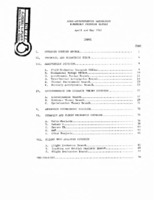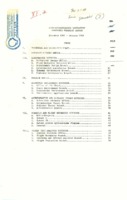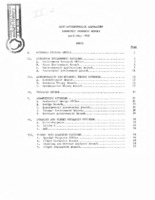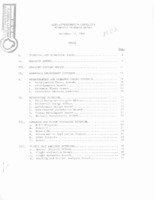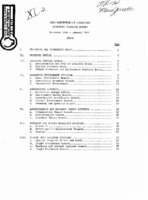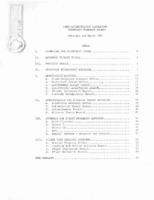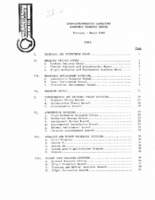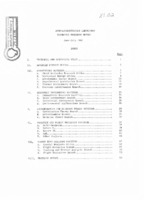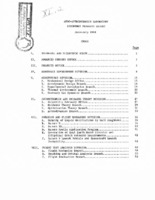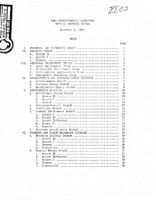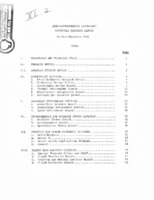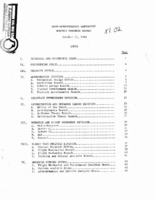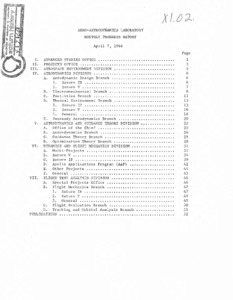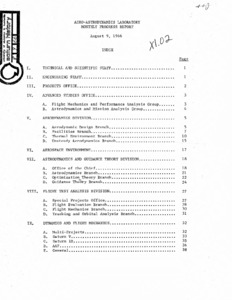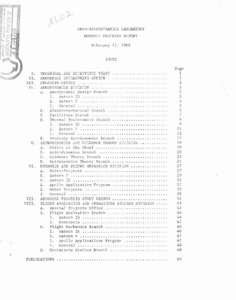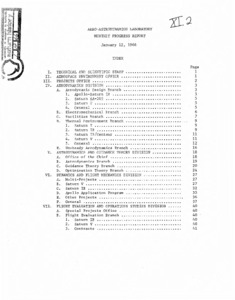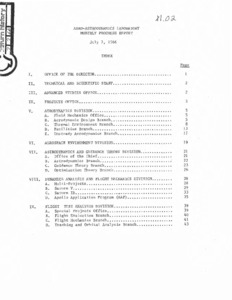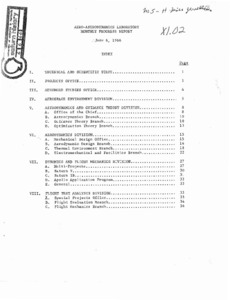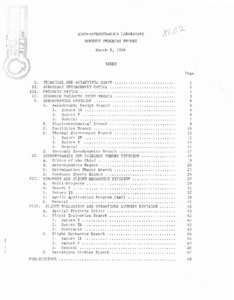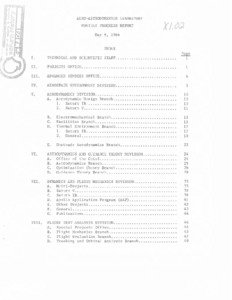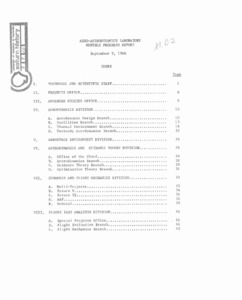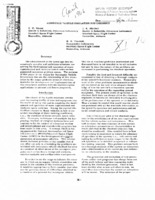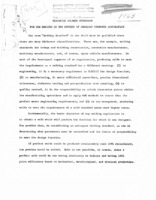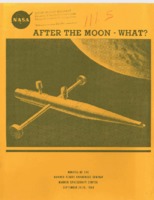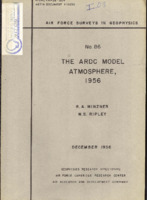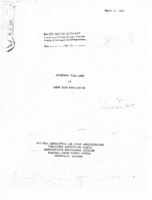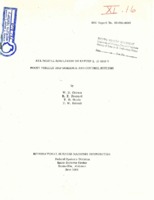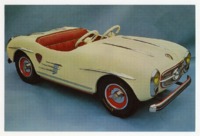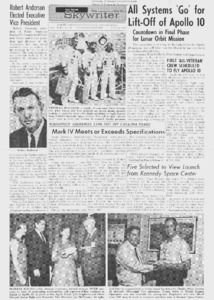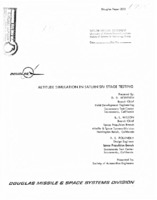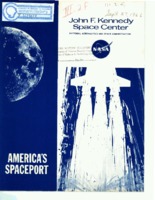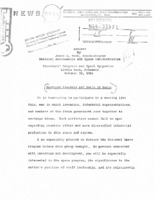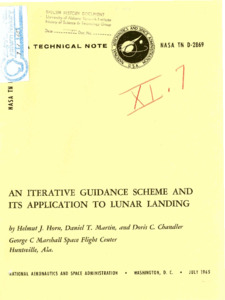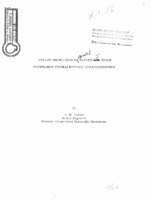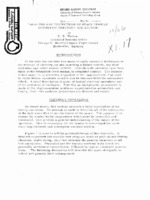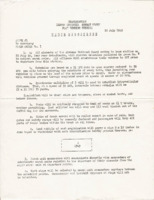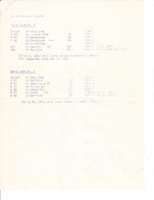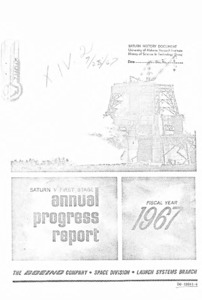
Browse Items (2178 total)
Sort by:
-
"Aero-Astrodynamics Laboratory Bimonthly Progress Report: April - May 1968."
Includes Advanced Studies Office, Aerospace Environment Division, Astrodynamics and Guidance Theory Division, Projects Office, Aerophysics Division, Dynamics and Flight Mechanics Division, Flight Test Analysis Division. -
"Aero-Astrodynamics Laboratory Bimonthly Progress Report: June - July 1968."
Includes Technical and Scientific Staff; Advanced Studies Office; Projects Office; Aerospace Environment Division; Aerophysics Division; Astrodynamics and Guidance Theory Division; Dynamics and Flight Mechanics Division; Flight Test Analysis Division. -
"Aero-Astrodynamics Laboratory monthly progress report : April 7, 1966."
"Monthly progress report : April 7, 1966." -
"Aero-Astrodynamics Laboratory monthly progress report : August, 1966."
Monthly progress report for August, 1966. -
"Aero-Astrodynamics Laboratory monthly progress report : February, 1966."
Monthly progress report for Febuary, 1966. -
"Aero-Astrodynamics Laboratory monthly progress report : January 12, 1966."
Monthly progress report for January 12, 1966. -
"Aero-Astrodynamics Laboratory monthly progress report : July, 1966."
Monthly progress report for July, 1966. -
"Aero-Astrodynamics Laboratory monthly progress report : June, 1966."
Monthly progress report for June, 1966. -
"Aero-Astrodynamics Laboratory monthly progress report : March 8, 1966."
"Monthly progress report : March 8, 1966." -
"Aero-Astrodynamics Laboratory monthly progress report : May, 1966."
Monthly progress report for May, 1966. -
"Aero-Astrodynamics Laboratory monthly progress report : September, 1966."
Monthly progress report for September, 1966. -
"Aerospace Vehicle Simulation and Checkout."
Paper by J. W. Moore and J. R. Mitchell, Quality & Reliability Assurance Laboratory, Marshall Space Flight Center, and H. H. Trauboth, Computation Laboratory, Marshall Space Flight Center. The paper summary notes, "The advancement of the space age into increasingly complex and ambitious missions requiring the development and operation of more sophisticated and intricate launch vehicles has generated numerous problem areas. The purpose of this paper is to define the Aerospace Vehicle Simulation; discuss the relationship of this simulation to the major problem areas of checkout; describe the development and implementation of this simulation system; indicate multidiscipline applications to present and future programs." -
"After the Moon - What? Minutes of the Manned Flight Awareness Seminar."
The seminar was held at the Manned Spacecraft Center, September 25-26, 1969. -
"Air Force Surveys in Geophysics: The ARDC Model Atmosphere, 1956."
This paper presents a "realistic model of atmospheric properties based on reliable observations and current theories" according to the abstract found on page xv. This 1956 ARDC model was meant to be used as the "basis for engineering and design work performed." -
"Alignment Tool Aids in Large Tank Fabrication."
Includes the clipping "Clamping Tool Aligns Odd-Shaped Sections for Welding" from <i>Design News</i>, September 4, 1963, written by Margaret A. Maas. -
"All Digital Simulation of Saturn I, IB, and V: Boost Vehicle and Guidance Control Systems."
The introduction notes, "The Saturn V launch vehicle is being developed by the National Aeronautics and Space Administration's George C. Marshall Space Flight Center for Project Apollo; Saturn I and Saturn IB vehicles are providing the early testing and support for Project Apollo. The nerve center of the Saturn is its guidance and control system. An airborne digital computer provides the link which closes both the guidance and control loops,making verification of the flight computer program of vital importance. During a powered flight this onboard digital computer program can be divided into four major parts:a) guidance, including navigation, b) control, c) vehicle sequencing, and d) computer telemetry." -
"All New Junior Hot Rod Car."
This flier has an image of the "All New Junior Hot Rod Car" as well as a description and a price for it. -
"All systems 'go' for liftoff of Apollo 10."
News article detailing that the final preparations for the lift-off of the Apollo rocket have been completed. -
"Altitude Simulation in Saturn SIV Space Testing."
This paper was presented to the Society of Automotive Engineers. The abstract reads, "The Douglas Aircraft Company has been involved in testing the Saturn SIV stage at the Sacramento Test Center for the past two years. The propulsion system for the SIV stage consists of six (6) Pratt & Whitney Aircraft Company rocket engines which are designed specifically for high altitude start and operation. During static firing tests of this engine at sea level, a steam jet ejector in combination with a diffuser, are used to simulate altitude conditions. The intent of this paper is to examine the performance of this altitude simulation system, and to discuss problems encountered in making it operational." -
"America's Spaceport."
Guide to John F. Kennedy Space Center, including an introduction from Center director Kurt Debus. -
"American Progress and Goals in Space," address by James E. Webb.
This address was given by James E. Webb, Administrator, National Aeronautics and Space Administration, at the Inventors' Congress and Space Symposium, Little Rock, Arkansas. -
"An Iterative Guidance Scheme and Its Application to Lunar Landing."
A guidance scheme for vehicle flight from lunar orbit to a prescribed point on a spherical, non-rotating moon is presented. The equations of motion have been simplified only to perm it a closed solution for the thrust magnitude and thrust direction. The trajectory computations them selves are made under more realistic and accurate assumptions and are not included. -
"Analog Simulation of Saturn S-IB Stage Propulsion System Dynamic Characteristics."
This copy has handwritten notes that change the title to read, "Analog Simulation of Uprated Saturn I Stage Propulsion System Dynamic Characteristics." The abstract notes, "The purpose of this paper is to present the techniques and logic employed in the development of an analog computer model to simulate Saturn IV first stage propulsion system dynamic characteristics. Restraints, problem areas, and major assumptions are included." -
"Annex #1 to accompany March Order No. 1".
This annex discusses the schedules, vehicle use, and uniforms for March Order Number 1. -
"Annex No. 2-March Tables".
These tables show March Units Numbers one through four with their miles, time, and units. -
"Annual progress report :1966-1967."
The Annual Progress Report from July 1st, 1966 through June 30thm 1967.
